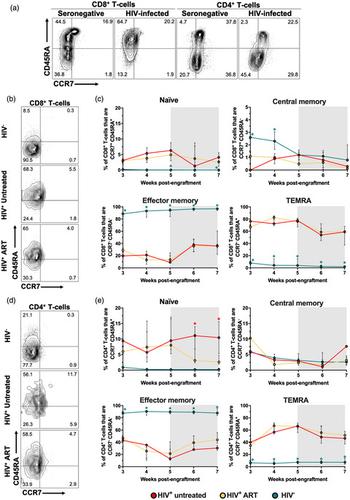当前位置:
X-MOL 学术
›
Clin. Exp. Immunol.
›
论文详情
Our official English website, www.x-mol.net, welcomes your
feedback! (Note: you will need to create a separate account there.)
High activation and skewed T cell differentiation are associated with low IL-17A levels in a hu-PBL-NSG-SGM3 mouse model of HIV infection.
Clinical & Experimental Immunology ( IF 3.4 ) Pub Date : 2020-01-21 , DOI: 10.1111/cei.13416 F Perdomo-Celis 1, 2 , S Medina-Moreno 2 , H Davis 2 , J Bryant 2 , N A Taborda 1 , M T Rugeles 1 , S Kottilil 2 , J C Zapata 2
Clinical & Experimental Immunology ( IF 3.4 ) Pub Date : 2020-01-21 , DOI: 10.1111/cei.13416 F Perdomo-Celis 1, 2 , S Medina-Moreno 2 , H Davis 2 , J Bryant 2 , N A Taborda 1 , M T Rugeles 1 , S Kottilil 2 , J C Zapata 2
Affiliation

|
The humanized NOD/SCID/IL-2 receptor γ-chainnull (NSG) mouse model has been widely used for the study of HIV pathogenesis. Here, NSG mice with transgenic expression of human stem cell factor (SCF), granulocyte-macrophage colony-stimulating factor (GM-CSF) and interleukin (IL)-3 (NSG-SGM3) were injected with peripheral blood leukocytes (PBL mice) from two HIV-infected (HIV+ ) patients who were under anti-retroviral therapy (ART; referred as HIV+ mice) or one HIV-seronegative healthy volunteer (HIV- ). Such mice are either hu-PBL-NSG-SGM3 HIV+ or HIV- mice, depending on the source of PBL. The kinetics of HIV replication and T cell responses following engraftment were evaluated in peripheral blood and secondary lymphoid tissues. High HIV replication and low CD4 : CD8 ratios were observed in HIV+ mice in the absence of anti-retroviral therapy (ART). Consistent with high activation and skewed differentiation of T cells from the HIV-infected donor, HIV+ mice exhibited a higher T cell co-expression of human leukocyte antigen D-related (HLA-DR) and CD38 than HIV- mice, as well as a shifted differentiation to a CCR7- CD45RA+ terminal effector profile, even in the presence of ART. In addition, HIV replication and the activation/differentiation disturbances of T cells were associated with decreased plasma levels of IL-17A. Thus, this hu-PBL-NSG-SGM3 mouse model recapitulates some immune disturbances occurring in HIV-infected patients, underlying its potential use for studying pathogenic events during this infection.
中文翻译:

在感染HIV的hu-PBL-NSG-SGM3小鼠模型中,高活化和偏斜的T细胞分化与低IL-17A水平相关。
人源化NOD / SCID / IL-2受体γ-链空(NSG)小鼠模型已广泛用于研究HIV发病机理。在这里,向具有人类干细胞因子(SCF),粒细胞巨噬细胞集落刺激因子(GM-CSF)和白细胞介素(IL)-3(NSG-SGM3)转基因表达的NSG小鼠注射外周血白细胞(PBL小鼠)来自两名接受抗逆转录病毒疗法(ART;称为HIV +小鼠)的HIV感染(HIV +)患者或一名HIV血清阴性的健康志愿者(HIV-)。取决于PBL的来源,这类小鼠是hu-PBL-NSG-SGM3 HIV +或HIV-小鼠。在外周血和次级淋巴组织中评估了植入后HIV复制和T细胞反应的动力学。在没有抗逆转录病毒疗法(ART)的情况下,在HIV +小鼠中观察到高HIV复制和低CD4:CD8比。与HIV感染的供体的T细胞的高活化和偏向分化一致,HIV +小鼠显示出比HIV小鼠更高的人类白细胞抗原D相关(HLA-DR)和CD38的T细胞共表达。即使在存在ART的情况下,也将分化转移至CCR7-CD45RA +末端效应子谱。此外,HIV复制和T细胞的激活/分化障碍与血浆IL-17A水平降低有关。因此,这种hu-PBL-NSG-SGM3小鼠模型概括了在HIV感染患者中发生的一些免疫干扰,潜在地用于研究这种感染期间的致病性事件。即使在存在ART的情况下,HIV +小鼠也显示出比HIV小鼠更高的人类白细胞抗原D相关(HLA-DR)和CD38的T细胞共表达,以及向CCR7- CD45RA +末端效应子谱的转移分化。 。此外,HIV复制和T细胞的激活/分化障碍与血浆IL-17A水平降低有关。因此,这种hu-PBL-NSG-SGM3小鼠模型概括了在HIV感染患者中发生的一些免疫干扰,潜在地用于研究这种感染期间的致病性事件。即使在存在ART的情况下,HIV +小鼠也显示出比HIV小鼠更高的人类白细胞抗原D相关(HLA-DR)和CD38的T细胞共表达,以及向CCR7- CD45RA +末端效应子谱的转移分化。 。此外,HIV复制和T细胞的激活/分化障碍与血浆IL-17A水平降低有关。因此,这种hu-PBL-NSG-SGM3小鼠模型概括了在HIV感染患者中发生的一些免疫干扰,潜在地用于研究这种感染期间的致病性事件。
更新日期:2020-01-21
中文翻译:

在感染HIV的hu-PBL-NSG-SGM3小鼠模型中,高活化和偏斜的T细胞分化与低IL-17A水平相关。
人源化NOD / SCID / IL-2受体γ-链空(NSG)小鼠模型已广泛用于研究HIV发病机理。在这里,向具有人类干细胞因子(SCF),粒细胞巨噬细胞集落刺激因子(GM-CSF)和白细胞介素(IL)-3(NSG-SGM3)转基因表达的NSG小鼠注射外周血白细胞(PBL小鼠)来自两名接受抗逆转录病毒疗法(ART;称为HIV +小鼠)的HIV感染(HIV +)患者或一名HIV血清阴性的健康志愿者(HIV-)。取决于PBL的来源,这类小鼠是hu-PBL-NSG-SGM3 HIV +或HIV-小鼠。在外周血和次级淋巴组织中评估了植入后HIV复制和T细胞反应的动力学。在没有抗逆转录病毒疗法(ART)的情况下,在HIV +小鼠中观察到高HIV复制和低CD4:CD8比。与HIV感染的供体的T细胞的高活化和偏向分化一致,HIV +小鼠显示出比HIV小鼠更高的人类白细胞抗原D相关(HLA-DR)和CD38的T细胞共表达。即使在存在ART的情况下,也将分化转移至CCR7-CD45RA +末端效应子谱。此外,HIV复制和T细胞的激活/分化障碍与血浆IL-17A水平降低有关。因此,这种hu-PBL-NSG-SGM3小鼠模型概括了在HIV感染患者中发生的一些免疫干扰,潜在地用于研究这种感染期间的致病性事件。即使在存在ART的情况下,HIV +小鼠也显示出比HIV小鼠更高的人类白细胞抗原D相关(HLA-DR)和CD38的T细胞共表达,以及向CCR7- CD45RA +末端效应子谱的转移分化。 。此外,HIV复制和T细胞的激活/分化障碍与血浆IL-17A水平降低有关。因此,这种hu-PBL-NSG-SGM3小鼠模型概括了在HIV感染患者中发生的一些免疫干扰,潜在地用于研究这种感染期间的致病性事件。即使在存在ART的情况下,HIV +小鼠也显示出比HIV小鼠更高的人类白细胞抗原D相关(HLA-DR)和CD38的T细胞共表达,以及向CCR7- CD45RA +末端效应子谱的转移分化。 。此外,HIV复制和T细胞的激活/分化障碍与血浆IL-17A水平降低有关。因此,这种hu-PBL-NSG-SGM3小鼠模型概括了在HIV感染患者中发生的一些免疫干扰,潜在地用于研究这种感染期间的致病性事件。









































 京公网安备 11010802027423号
京公网安备 11010802027423号